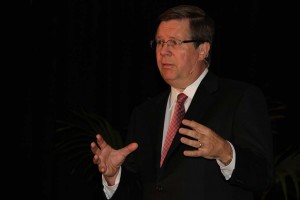
Toyota's Jim Lentz says Toyota's version of autonomous vehicles will improve driver's ability, not take over the entire process.
When the future finally gets here and we’re all driving, or riding in, autonomous cars, the Toyota badge may not be on the side of your ride, according to Jim Lentz, Toyota North America CEO.
The Japanese carmakers’ plans for autonomous vehicles fall more into the realm of helping drivers improve their skills rather than allowing drivers to sit back and read the paper while the vehicle does the work.
“We view autonomous cars a little differently than some others. We really see it as a co-pilot type car, not as a self-driving car,” Lentz, the first American to head Toyota’s vast operations in the NAFTA region, told the Associated Press. “A car that can really enhance the reflexes and the ability of a driver to continue to drive. That’s why I’m excited about those cars. As we look at boomers and they start to retire, the ability to have cars that can enhance their capabilities, it’s going to allow them to drive much longer.”
Toyota’s driverless car technology has an advanced cruise-control system that uses wireless communication with nearby vehicles to determine a safe distance to follow. The company also uses a lane-monitoring technology that allows the steering wheel to keep to its highway lane. The company recently began testing the technology.
The focus on improving technology in cars and trucks is resulting in a two-track approach to using it. The first is the aforementioned efforts related to safety, such as adaptive cruise control, the second is for driver convenience, such as infotainment. Ensuring Toyota’s considered a leader in that arena means developing systems that are appealing to a wide buyer base, especially younger buyers who do not feel the same compulsion to own a vehicle as previous generations.
“The technology we put in cars has to be very, very intuitive so that it’s simple to use for elder generations but enough techno for younger generations,” Lentz said. “But younger generations, I don’t think they’re necessarily amazed with technology. It’s a tool to them.”
However, it’s not just the use of technology that Toyota must deal with in the battle for younger buyers, but also a slew of socio-economic forces impacting potential buyers, who have recently graduated from college.
Recent college graduates are leaving their institutions of higher learning with more student loan debt that any generation before them. Compounding the problem is the fact that the economy is still volatile with a high rate of unemployment and lower salaries that the preceding wave of graduates.
“Despite the debt and despite either underemployment or lower salaries, those under 35 are coming back to the market at a faster rate than any other generation,” Lentz said.
“As they start lifestyle changes, married, someday kids, they are coming back. They’ll have to deal with their college debt. But I don’t think it’s going to put that much of a damper on the industry long-term. We are going to have very soon five different generations buy cars for the first time.”
It’s that shift that may be helping Toyota recover the market share it lost a few years back. The company’s U.S. market share hovered in the 16% to 17% range for most of the previous decade. Then the economy went into recession, a tsunami hit Japan in 2009 and a series of quality issues resulting in several recalls pushed that number down to 12.8%.
Since then, the company has clawed back to 14.4% in spite of those issues as well as increased competition in the maker’s strongest segment: midsize cars. Toyota boasts the best selling car in the U.S.: the Camry. However, U.S. and Korean automakers have produced a spate of compelling vehicles in that range that are making it tough for Toyota to keep that No. 1 title.
(Toyota cuts prices on electric vehicles. For more, Click Here.)
“If you go back 15 years, there were really two major players, Accord and Camry. Today there are arguably five or six really good options,” he said. “We will be competitive in the marketplace and the numbers shake out where the numbers shake out. This year I’m quite confident we’ll remain No. 1.
“There’s great competition. Accord is that much newer in the marketplace than we are. And arguably the midsize market has been changed forever by the Hyundai Sonata. I think Sonata really brought aggressive styling into a segment that had not been that aggressively styled. In future generations of Camry, the styling will get more aggressive. What I call emotional quality is improving on each and every one of our vehicles.”
(Click Here to review Toyota’s plans to export U.S.-built vehicles.)
Lentz, who has been with Toyota since 1982, has overseen the growth of Toyota’s North American operations, including a recent push to export Toyota vehicles from North America. The company plans to export the 2014 Corolla to 18 countries in Latin America and the Caribbean starting next year.
“Toyota’s U.S. manufacturing operations continue to grow as a key supplier of cars and trucks for global markets, which is only possible thanks to the dedication and high-quality work of our team members here,” said Lentz, earlier this year, “the export of U.S.-built Corolla sedans to Latin America and the Caribbean will help to further solidify our U.S. manufacturing base.”
Toyota earlier this year began shipping its Venza crossover from the U.S. to Russia and the Ukraine and last year added several American-made products to its line-up in South Korea. That is likely to push its total exports to a new record in 2013 after hitting a previous high last year. In fact, 2012 saw exports rise 45% to 124,000 with U.S.-made Toyotas shipped to 21 global markets.
